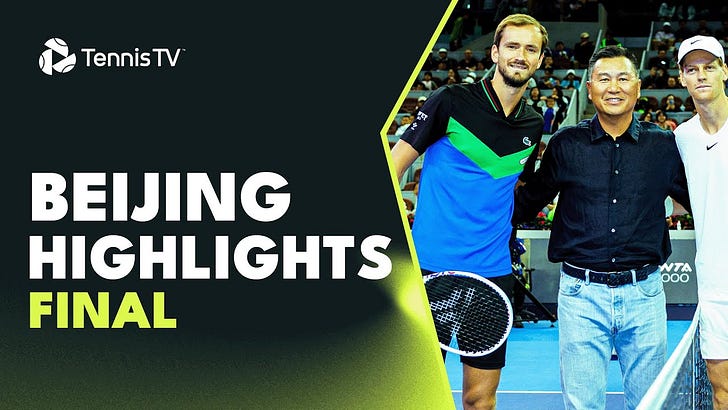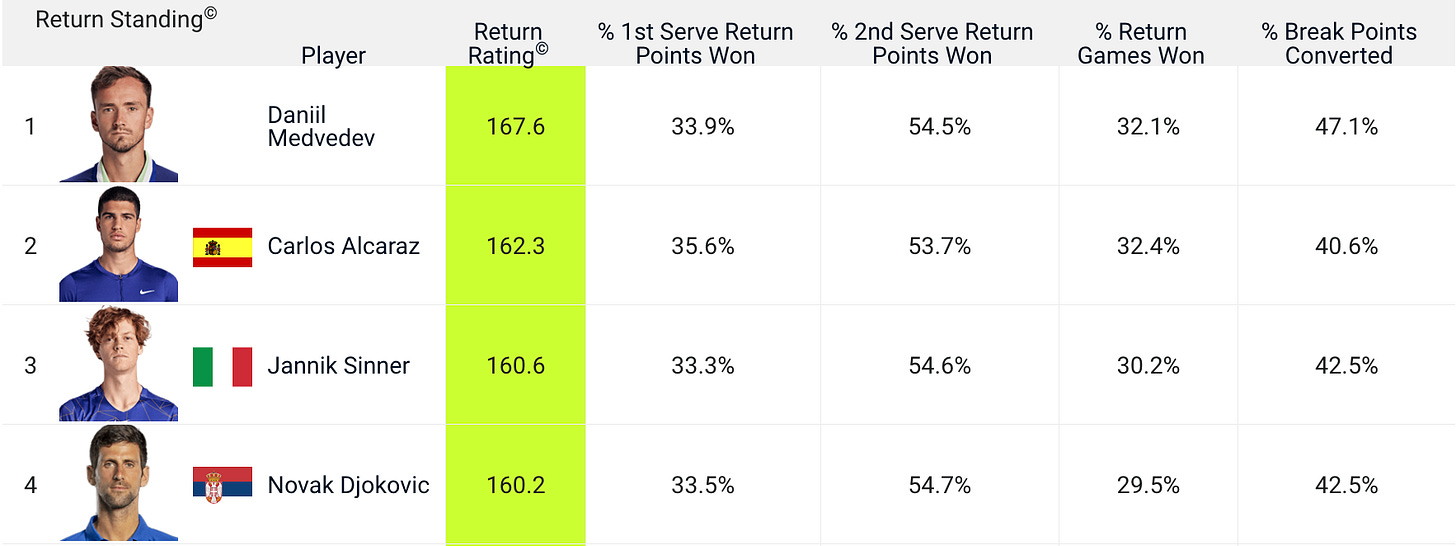Sinner v Alcaraz
Given the buzz the Sinner-Alcaraz rivalry is generating in the tennis world, I figured I would add some thoughts on that match before getting into the final analysis.
I only caught the backend of the match live, and my initial thoughts were that Alcaraz still hadn’t taken a leaf out of the Medvedev/Zverev/Djokovic playbook and knuckled down with deep middle defense (Sinner was 1-13 vs. these three counterpunchers).
However, on watching a replay it was clear early on that Alcaraz was trying to emulate those counterpunchers. The first few games were brilliant constricting tennis from Alcaraz: playing deep middle, mixing up the heights and spins, and overall playing well within his usual aggressive instincts.
Sinner was missing.
At 2-0, Alcaraz had a couple of break points and missed two deep, defensive forehands into the net. The kind of miss he would hate (into the net trying to play a high defensive forehand!). Here’s one:
In that 2-0 game he missed three forehands—two on break points and one on game point—in this exact fashion. Rushed wide and deep he dumped them all in the net. The next game he flyed a couple of forehands long—this time from the neutral position—and Sinner broke back.
But Alcaraz continued to play patient and absorbing tennis in that first set, and he created break point chances in all of Sinner’s first three service games, breaking twice. In fact, he got to 30 or deuce in all of Sinner’s service games until 4-1 down in the second.
It’s clearer to me now that Alcaraz has figured out the plan against Sinner, he just hasn’t been able to execute it as well, particularly on big points.
After the first few games, Sinner’s level from the middle was very impressive; his linear power from both wings rushed Alcaraz, and I don’t think Alcaraz is quite as comfortable as the Medvedev’s and Djokovic’s of the world at absorbing pace–especially on his forehand—and being able to redirect it with control. He likes to attack himself. He likes to use width, drop shots, and variation. Sinner in his on-court interview after the match:
“I think the execution went really well..trying to stay aggressive, because when he [Alcaraz] has a lot of time he plays really really good and [is] really aggressive.”
Both these guys like to dictate, but against each other, I think Sinner has the upper hand in the bread-and-butter B/C linear exchanges:
TennisTV: “A couple of times we’ve seen Alcaraz really go big—an injection of pace—to the forehand of Sinner: that shot holds up very well, he’s very good, if he’s nice and balanced behind the ball, at just shortening up the swing, soaking it up, it’s not going to bother him too much, that pace coming through. I think a bit more width might.”
But Sinner makes it hard for Alcaraz to find that width because his linear power is so strong.
TennisTV: “I think Sinner’s done a really good job of making this match, I think after the first couple of games, it’s become a lot narrower, which is exactly what he wants to see. Alcaraz is someone who loves to drag his opponents well outside the tramlines. It just feels like he hasn’t had as many opportunities to do that.”
Additionally, when Alcaraz dons his counterpunching hat—especially on his forehand—his ball bounces higher than the Medvedev’s and Djokovic’s given his extra topspin, and I think this suits Sinner with his more extreme grip and swing. A couple of times Sinner got a hold of a forehand around his shoulders, and he looked far more dangerous and comfortable at that height.
I’ve written several times about how the running forehand has been a sore point for many players and compared it to Djokovic’s supreme ability from position D. Sinner is another player whose (in my mind) weakest shot is the wide forehand where he is forced to hit while moving to that side.
Here are 16 Sinner forehands from position D ( I think that’s all of them) from his match against Alcaraz:
A breakdown of these shots reveals that he missed 8/16. If we break down his footwork on each of these we get the following:

One match is too small a data set, and there are pros and cons to the type of ball and recovery that can be made with these various footwork patterns on the wide forehand, but my hunch is that this is par for the course for Sinner, and perhaps he could stop the leak on his wide forehand with adjustments to his decision-making out wide in terms of footwork. The step-over forehand is usually reserved for end-range shots these days, but I feel it aids timing as it keeps the upper body quieter and can maybe be employed by someone like Sinner (I touched on this in Federer’s movement piece) to shore up this area of his game when he is rushed. The sliding forehand is the same; note how quiet and controlled his upper body is when he plays the sliding forehand, plus he can recover the fastest, meaning a more defensive, or slower, ball isn’t as vulnerable to getting smacked for a winner on the next ball.
While the open-stance hop forehand allows you to recover faster while still unloading on the ball with big power, it seems to be a shakier shot. I think the same is true for Alcaraz, who I felt made great forehand adjustments at Wimbledon.
What’s more, Sinner is truly an elite returner (and the stats below affirm that), and the vast majority of his (and most other players’) return-of-serves on a forehand are used with a step-over.
Ultimately, this is a rivalry that will be (and has been) fascinating to follow as both try to add tools and tactics to overcome the other in the years ahead. Tennis is lucky to have such talent bunched in similar age brackets, and I think both will be fighting for the biggest silverware often throughout this decade.
Sinner v Medvedev
Sinner was looking to reverse a 0-6 H2H against Medvedev coming into this final. Following their Miami Masters 1000 final in April, it was clear that this matchup required more than just brute power from Sinner if he was going to overcome these deep counterpunchers. An excerpt from that match analysis:
“The opening rallies of this encounter showcased why Sinner struggles against the baseline sponge that Medvedev embodies. The Russian loves to absorb. The harder the better. Sinner’s game—as it currently stands—is all about aggression; he loves to attack. Neither player has great intangibles (yet) such as short slices, net sneaks, or drop shots to effectively break this standoff. The second rally of the match was 19 shots.”
But as I’ve touched on numerous times this season (here and here) Sinner has been one of the youngsters who has continually showcased a willingness to change and tinker—technically and tactically—in search of improvements right before our eyes. An excerpt from the Wimbledon semifinal preview:
“Sinner’s been this guy who has only ever really taken incremental steps in his career, but he’s been taking steps nonetheless, and he’s showcased a mentality that has been willing to change and adapt to improve. We’ve seen serve changes, more use of the drop shots, and the addition of Darren Cahill to the coaching staff.”
On the third point of the match Sinner displayed some improved intangibles around the net and went straight to the serve-volley playbook:

The very next game Medvedev showcased why he’s such a headache for linear power players: he stands so far back that the effect of the power gets watered down:
But Sinner was patient in Beijing. His aggression was more measured, and he added in angled elements with net play: the same elements that someone like Alcaraz loves to use.
Additionally, Sinner’s improved physicality was on display these last couple of days. His movement was Djokovic-esque. The point below is an absurd blend of firepower and end-range shotmaking:
His ability to stay healthy and maintain this kind of fitness is probably still the biggest question mark, one he has been answering slowly but surely this year as he picked up his third title of the year yesterday, a result buttressed by numerous deep runs in other events.
Interestingly, I took the wide forehand stats for Sinner in this final and got a very handsome open-stanced result:
I think this reflected Sinner’s game plan to stay patient against Medvedev, as well as Medvedev’s relatively more underpowered game. Sinner could afford to play safer knowing he wasn’t going to get punished or rushed by the Russian.
The rap sheet:

Sinner now rises to a career-high world number 4, behind Djokovic, Alcaraz, and Medvedev.
It will be interesting to see if Jannik can back it up with a good showing in Shanghai now. The best players bring it week after week.
I’ll be back with a final analysis next week.
I’ve got a couple of other pieces juggled at the moment in my drafts and hopefully will get them out in the coming weeks after I cover Shanghai.











Loved those clips of the sinner out wide forehands! You make your points very understandable.
Sinner does have an elite return of serve as you say. And he can afford to be patient vs Med as Med can truly only hurt him with his serve. No player to me has the effortless pop/injection of pace off the forehand like Sinner, best in that regard since Federer. And his backhand is top notch. Totality of both wings, no player can take away time like Sinner. It was interesting to me to watch the contrast in forehand technique Sinner and Alcaraz. Alcaraz has the Federer, Nadal, Tsitsipas. Rune etc straight arm pull to contact technique. Sinner has the next gen bent arm/side arm throw technique of Sock, Kyrgios, Berrenttini, Fognini, etc.